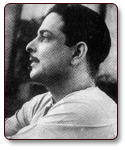
government is the landlord with the largest surplus landholding. goverment is the tycoon who owns ships, planes, buses, trains, trucks and cars. government is the businessman who runs factories, mills, mines, quarries and souvenir stores. government is the investor with interests in healthcare, hospitality, travel & leisure, financial services, energy, food processing, warehousing, insurance, armaments, telecom, construction and housing, infrastructure and information technology.
would you like to do business with him ? (who wouldn't, right ?)
you can meet him at any of his offices all over the country. he is the the man with the unctuous smile and the outstretched hand. if he's not in, you might run into him at any street corner, dressed in a uniform, waving a lathi or a gun or, once again, an outstretched hand. or if you're lucky he might call on you at your home or your workplace. that'd be the hectoring stranger with a lathi or a gun or an outstretched hand. he might be waving a bill, a notice, a warrant, an order or none of the aforementioned.
you should start worrying when it's none of the aforementioned.
you'd be well advised to meet him on his own ground. say, on the piece of his land that you've occupied. he is a tough negotiator: if you don't like any of his rules, break them in his full view so that he'd respect you more. he doesn't like dishonesty and crookedness. if you plan to steal from him, tell him beforehand so that he'd know when to look the other way. he is obsessed with quality. if you build a bridge for him, and it's washed away, say, after five years, he'd expect you to build another of the same quality. he likes risktakers- if you succeed in duping him to the tune of a major fortune, he'd provide you with top class security at his own cost. the courts are his favorite playground. he'd like all his vendors to play a game or two of 'dispute' with him every once in a while.
those who refuse to play ball encounter more than a little misfortune.
he knows everyone. you'd encounter his name, and his various aliases, listed in the books, diaries and other records of a wide range of professionals - pimps, power brokers, smugglers, gunrunners, hawala operators, counterfeiters and others. you'll never find their names in his good books, because he is not a name-dropper. but he is their loyal friend - any offer they make him, he accepts.
if you'd like to know more about him, call on him tomorrow...
today is his 58th birthday and if you don't wish to encounter any stray bullet or bomb, stay away from the celebrations








